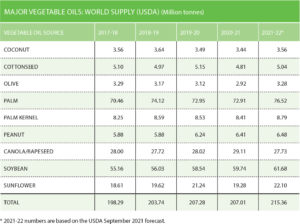Canola Market Snapshot
It came as no surprise to anyone in Western Canada when September reports from Statistics Canada and the United States Department of Agriculture (USDA) predicted a big drop in Canadian canola production after drought and heat took down yields.
Statistics Canada’s mid-September update reduced its canola forecast to 12.8 million tonnes for 2021. The yield estimate was 25.3 bu./ac., which is well below the average of just over 40 bu./ac. for the previous five years.
The USDA, in its September Oilseeds: World Markets and Trade report, estimated Canadian canola production at 14.0 million tonnes. The October report will likely have a lower number.
Meanwhile, canola/rapeseed production for the rest of the world was holding on. USDA estimates for all other canola/rapeseed (simply “canola” from here on) production areas around the world are flat to up slightly. While its Canadian estimate is down almost seven million tonnes from the year before, USDA shows a 1.5 million tonne increase for everywhere else. Production for other oilseed crops is also up.
Global Oilseed Production
The USDA, in the same September report, estimated global 2021-22 oilseed production at 629 million tonnes for the eight major oilseed crops. This is up from 601 million in 2020-21. Soybeans, up 20 million tonnes year over year, account for most of the increase. The rest comes from sunflowers, up seven million tonnes to a forecast 57 million. All other major oilseeds are up slightly. Only canola supply, at 68.2 million, is down.
Production of major vegetable oils, a list that also includes palm, is at 215.4 million tonnes in the USDA September report. This is up eight million from 2020-21. Palm oil accounts for 3.5 million of that gain.
Where to next?
While Canadian canola production had a tough year, all is not doom and gloom. Announcements of three new canola processing plants and the doubling of a fourth in Saskatchewan point to confidence in Canadian canola to get supply back on track – once the weather cooperates. These companies expect canola oil demand to increase substantially, driven by growth in global vegetable oil consumption and by pending biofuels policies in the U.S. and Canada.
The world may need an increase in Canadian canola production to address potential supply issues elsewhere.
Each year, the Organisation for Economic Co-operation and Development (OECD) and the Food and Agricultural Organization (FAO) of the United Nations collaborate on an agricultural outlook for the coming decade. The 2021 outlook, which looks ahead to 2030, includes a chapter on oilseeds and oilseeds products.
The report notes that while global palm oil output has outpaced the production of other vegetable oils over the past decade, “growth in the production of palm oil is expected to weaken due to increasing attention to sustainability concerns and the aging of oil palm trees in Indonesia and Malaysia.”
The OECD and FAO report also expects limited growth for major canola producers China and the European Union “as relatively higher prices for cereals are expected to generate strong competition for limited arable land.” They give Canada an oilseeds production figure of 23 million tonnes by 2030, which is decent growth but probably conservatively low. The Canola Council of Canada strategic goal is to reach 26 million tonnes by 2025. With co operative weather and current acreage levels of around 22 million, this target is achievable. (The Canadian record is 21.5 million tonnes of canola, set in 2017.)
The report adds that Ukraine and Russia, which continue to put more arable land into production in the Black Sea region, could also see strong growth in oilseeds production.
All in all, the OECD and FAO report projects that global demand for vegetable oil will expand by 33 million tonnes by 2030.

Data from the United States Department of Agriculture’s Foreign Agricultural Service (“Oilseeds: World Markets and Trade”, September 2021) show a continued and steady increase in global vegetable oil production. The Organisation for Economic Co-operation and Development (OECD) and the Food and Agricultural Organization (FAO) of the United Nations, in a 2021-30 forecast, project global demand for vegetable oil will expand by 33 million tonnes through this decade.





